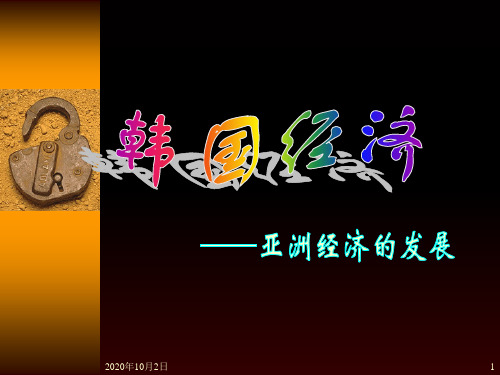韩国经济的PPT
合集下载
韩国经济发展状况完美版PPT

《韩国经济发展状况完美版ppt》
xx年xx月xx日
目录
contents
引言韩国经济概述韩国经济增长因素分析韩国经济面临的挑战与对策结论和建议
引言
01
VS
介绍和分析韩国经济的发展状况,包括趋势、影响因素和前景等,为投资者和决策者提供参考。
背景
韩国是一个重要的经济体,其经济发展趋势和前景对全球经济具有影响。近年来,韩国经济面临了一些挑战和机遇,了解其经济发展状况具有重要的现实意义。
韩国将进一步融入全球经济体系,利用其技术和制造业优势,扩大在国际贸易中的份额。
韩国将加强与亚洲各国的经济合作,以降低地缘政治风险和应对全球经济不确定性。
韩国经济面临的挑战与对策
04
低生育率与老龄化问题
随着生活水平的提高,韩国的生育率持续下降,同时人口老龄化问题日益严重。这不仅加重了社会福利负担,也影响了劳动市场的活力和经济的持续发展。
外部因素
韩国经济增长的驱动力
内部因素
国内劳动力市场紧张、资源有限、环境压力等。
外部因素
全球经济不稳定、国际贸易摩擦、地缘政治风险等。
韩国经济增长的制约因素
韩国经济增长的未来趋势
韩国将继续受益于全球经济复苏和国内产业结构优化,预计未来几年经济将继续保持增长。
趋势一
趋势二
趋势三
趋势四
韩国将努力改善国内劳动力市场和资源环境问题,以适应更长期的经济增长。
目的
报告目的和背景
报告范围和内容
本报告涵盖了韩国经济的多个方面,包括国内生产总值、就业、物价、国际收支、财政和货币政策等。
范围
本报告将详细介绍韩国经济的发展趋势和影响因素,分析经济中存在的问题和挑战,预测未来的经济发展前景,并提出相应的政策建议。
韩国建立知识驱动的经济课件

交流平台
韩国政府搭建国际交流平台,促进知识、技术和人才的跨国流动,推动国际间的知识经济发展合作。
国知
04
的成果与影响
取得的成果和进步
经济增长
产业转型
韩国在知识驱动的经济模式下,实现了持 续的经济增长。这种增长主要依赖于技术 进步、创新和高素质的人力资源。
韩国成功地从传统的劳动密集型产业向技 术密集型和知识密集型产业转型,提升了 整体产业的竞争力。
对于个人而言,韩国经验启示我们,要不断学习和提升自己 的知识水平,增强自身的核心竞争力。同时,要勇于尝试和 冒险,不断拓展自己的视野和经验,以适应快速变化的社会 和经济环境。
对教育和研究的建议和方向
在教育方面,韩国经验提示我们,应该注重培养学生的创 新思维和实践能力,加强产学研合作,推动科技成果的转 化和应用。同时,应该注重教育公平和质量提升,提高整 体教育水平。
研发实力增强
教育和人才培养
韩国在研发方面的投入持续增加,培养了 一大批高素质的科研人员,推动了科技创 新的快速发展。
韩国重视教育和人才培养,通过高等教育 和研究机构,为知识经济的发展提供了源 源不断的人才支持。
对国内和国际的影响
国内影响
知识驱动经济为韩国带来了社会经济的 繁荣,提高了国民的生活水平,增强了 国家的综合实力。同时,也带来了一些 挑战,如收入差距的扩大、就业结构的 调整等。
VS
国际影响
韩国在知识驱动经济方面的成功经验,为 其他发展中国家提供了借鉴和启示。韩国 的科技创新、教育体系和人才培养模式受 到了国际社会的广泛认可和赞誉。
对未来的展望和计划
持续创新
韩国将继续加大在科技创新方面 的投入,鼓励企业进行研发活动, 推动产业技术的不断升级。
韩国政府搭建国际交流平台,促进知识、技术和人才的跨国流动,推动国际间的知识经济发展合作。
国知
04
的成果与影响
取得的成果和进步
经济增长
产业转型
韩国在知识驱动的经济模式下,实现了持 续的经济增长。这种增长主要依赖于技术 进步、创新和高素质的人力资源。
韩国成功地从传统的劳动密集型产业向技 术密集型和知识密集型产业转型,提升了 整体产业的竞争力。
对于个人而言,韩国经验启示我们,要不断学习和提升自己 的知识水平,增强自身的核心竞争力。同时,要勇于尝试和 冒险,不断拓展自己的视野和经验,以适应快速变化的社会 和经济环境。
对教育和研究的建议和方向
在教育方面,韩国经验提示我们,应该注重培养学生的创 新思维和实践能力,加强产学研合作,推动科技成果的转 化和应用。同时,应该注重教育公平和质量提升,提高整 体教育水平。
研发实力增强
教育和人才培养
韩国在研发方面的投入持续增加,培养了 一大批高素质的科研人员,推动了科技创 新的快速发展。
韩国重视教育和人才培养,通过高等教育 和研究机构,为知识经济的发展提供了源 源不断的人才支持。
对国内和国际的影响
国内影响
知识驱动经济为韩国带来了社会经济的 繁荣,提高了国民的生活水平,增强了 国家的综合实力。同时,也带来了一些 挑战,如收入差距的扩大、就业结构的 调整等。
VS
国际影响
韩国在知识驱动经济方面的成功经验,为 其他发展中国家提供了借鉴和启示。韩国 的科技创新、教育体系和人才培养模式受 到了国际社会的广泛认可和赞誉。
对未来的展望和计划
持续创新
韩国将继续加大在科技创新方面 的投入,鼓励企业进行研发活动, 推动产业技术的不断升级。
世界经济之韩国PPT

韩国经济发展概况
韩国是全球第15大经济体,拥有三星 (Samsung)和现代(Hyundai)等知名跨国企业, 以及一个适合发展中国家借鉴的腾飞模式。 20世纪60年代后,韩国开始推行外向型的 经济发展战略,用了40多年的时间,把人 均国民收入从60多美元提高到2015年的2.8 万美元,成为令世人瞩目的新兴工业化国 家。与新加坡、香港和台湾并称“亚洲四 小龙”,并且创造了举世瞩目的“汉江奇 迹”。
•
•
(三)经济发展对国外市场和资源依赖程度高,贸易依存度高达60%以上。 随着多年发展国内市场接近饱和,国内劳动力密集型产业正逐步向中国等 国进行转移。
(四)大企业作用举足轻重,三星、现代、SK等大企业集团数量虽少, 但创造的价值在国民经济中所占比重超过60%。
•
三、存在的问题
1、从崛起到原地踏步 最新的研究显示,韩国的增长潜力──在劳动力和资本等所有生产要素发挥作用时最大可能 的产出──现在接近每年4%,但未来十年可能缩减至2%到3%之间。韩国目前则在人均2万 美元的水平徘徊。 2、就业人口不足 (1)出生率低。韩国出生率为每名女性1.15个孩子,在发达国家中位列倒数第一。25岁 到49岁年龄组的人口数量早就从高峰处滑落;大约在2017年到2019年,韩国总的适龄工 作人口将开人都接受了高等教育,越来越少的 人愿意从事低收入、低技能的工作,导致该国的农业和制造业劳动力急缺。 3、政府干预过多 资本密集型的建设项目是韩国政治领袖发挥影响力的主要工具,他们不但能影响私有项目 的开发成本,而且能左右项目用地的可用程度。 原因:韩国社会深受儒家思想的影响,认同社会权力的等级制度。 4、外籍劳工政策不利 目前,韩国有557,000名外籍劳动力,在其2300万劳动大军中只占2%左右。 然而,根据韩国的劳动法规,外国人只能在韩资企业工作五年。
《韩国经济发展状况》课件

02
中韩自贸协定的签署为两国经贸合作提供了更加广阔的空间,
进一步促进了双边贸易和投资的增长。
两国在基础设施建设、新能源等领域也有着广泛的合作空间,
03
正在积极探讨合作项目。
中韩经贸关系发展前景与展望
中韩两国经济具有很强的互补性,未来经贸合 作仍有很大的发展空间。
两国政府和企业界应加强沟通与合作,共同应 对全球经济不确定性带来的挑战,推动双边经 贸关系向更高水平发展。
工业起步
开始发展轻工业和纺织业,逐 步实现自给自足。
基础设施
加强基础设施建设,改善交通 、通讯等条件。
出口导向型发展阶段(1961-1990)
总结词
出口导向战略,经济快速增长,国际竞争力 提升。
产业结构调整
重点发展重工业和化学工业,优化产业结构 。
外贸依存度提高
加强出口导向,提高外贸依存度,扩大外汇 储备。
地方经济
韩国各地经济发展不平衡 ,地方经济以传统产业和 农业为主导。
区域合作
韩国积极参与区域经济合 作,与周边国家和地区开 展广泛的经济合作与交流 。
02 韩国经济发展历 程
战后恢复期(1945-1960)
总结词
经济基础薄弱,重点恢复生产 ,奠定基础。
农业发展
重视农业发展,提高农业生产 效率,增加粮食产量。
1
韩国是中国的重要贸易伙伴之一,两国经贸往来 频繁。
2
中韩两国在贸易、投资、科技、文化等领域的合 作不断深化,取得了一系列重要成果。
3
两国在贸易方面呈现出较强的互补性,韩国在汽 车、钢铁、造船等领域具有优势,而中国在劳动 力、市场等方面具有优势。
中韩经贸合作领域与项目
01
《韩国的宏观经济》课件

讨韩国与中国之间的经贸合作 和文化交流。
结论
1 韩国经济的发展与经验值得借鉴
总结韩国经济发展的成功经验,并思考如何将其运用到其他国家。
2 韩国如何应对未来世界经济的变化并持续发展
探讨韩国在全球化、技术创新和可持续发展等方面的应对策略。
参考文献
1 相关书籍、论文、报告、新闻等
《韩国的宏观经济》PPT 课件
韩国是一个充满活力和创新的国家,拥有令人惊叹的自然风景和丰富的文化 遗产。本课件将介绍韩国的宏观经济,探讨其经济概况、产业结构以及与世 界经济的联系。
韩国的国情概括
1 韩国是什么样的国家?
了解韩国的地理位置、人口、文化和政治制度。
2 韩国的国情概括
了解韩国的国家形象、社会现状和国际地位。
韩国经济的起步和历程
1
韩国经济现状
2
分析当代韩国经济的特点、挑战和机遇。
3
朝鲜战争后的重建
探讨韩国经济如何在战后迅速恢复并取得快 速增长。
韩国主要的经济指标
介绍韩国的国内生产总值、外贸状况和财政 状况等重要指标。
韩国的产业结构
韩国的三大产业
详细介绍韩国的第一、第二和 第三产业,并分析它们在经济 中的作用。
列出参考文献,供进一步深入研究。
韩国的主要行业和优势 产业
探讨韩国在电子、汽车、航空 航天等领域的主导地位和竞争 优势。
韩国经济的发展趋势和 未来展望
展望韩国经济未来的发展方向 和挑战。
韩国与世界经济的联系
韩国的国际经济地位和影响
分析韩国在世界经济中的地位和 对全球经济的影响。
韩国与中美经济关系
讨论韩国与中美两大经济体之间 的贸易和合作关系。
结论
1 韩国经济的发展与经验值得借鉴
总结韩国经济发展的成功经验,并思考如何将其运用到其他国家。
2 韩国如何应对未来世界经济的变化并持续发展
探讨韩国在全球化、技术创新和可持续发展等方面的应对策略。
参考文献
1 相关书籍、论文、报告、新闻等
《韩国的宏观经济》PPT 课件
韩国是一个充满活力和创新的国家,拥有令人惊叹的自然风景和丰富的文化 遗产。本课件将介绍韩国的宏观经济,探讨其经济概况、产业结构以及与世 界经济的联系。
韩国的国情概括
1 韩国是什么样的国家?
了解韩国的地理位置、人口、文化和政治制度。
2 韩国的国情概括
了解韩国的国家形象、社会现状和国际地位。
韩国经济的起步和历程
1
韩国经济现状
2
分析当代韩国经济的特点、挑战和机遇。
3
朝鲜战争后的重建
探讨韩国经济如何在战后迅速恢复并取得快 速增长。
韩国主要的经济指标
介绍韩国的国内生产总值、外贸状况和财政 状况等重要指标。
韩国的产业结构
韩国的三大产业
详细介绍韩国的第一、第二和 第三产业,并分析它们在经济 中的作用。
列出参考文献,供进一步深入研究。
韩国的主要行业和优势 产业
探讨韩国在电子、汽车、航空 航天等领域的主导地位和竞争 优势。
韩国经济的发展趋势和 未来展望
展望韩国经济未来的发展方向 和挑战。
韩国与世界经济的联系
韩国的国际经济地位和影响
分析韩国在世界经济中的地位和 对全球经济的影响。
韩国与中美经济关系
讨论韩国与中美两大经济体之间 的贸易和合作关系。
韩国经济发展PPT培训资料课件

经济自由化阶段则重点在于放松管制、私有 化和市场化改革,为韩国经济的持续发展奠 定了基础。
韩国经济体制和结构
韩国实行的是资本主义市场经济体制,政府在经济发展中扮 演着重要的角色。韩国经济以中小企业为主导,同时也有一 些大型企业集团。
韩国的产业结构以制造业和服务业为主,其中制造业占据了 国内生产总值的三分之一以上。服务业的比重也在逐年增加 ,成为推动韩国经济发展的重要力量。
经济危机与复苏(2000-2010)
总结词
经济危机与复苏阶段,韩国经济受到全球经济危机的影响,但政府采取了有效的应对措施,实现了经 济的快速复苏。
详细描述
21世纪初,全球经济危机对韩国经济造成了严重冲击。然而,韩国政府采取了一系列有效的应对措施 ,如加大公共投资、减税、扶持中小企业等,实现了经济的快速复苏。同时,韩国企业也积极应对危 机,通过创新和转型升级来提高竞争力。
创新导向型经济(2010-至今)
总结词
创新导向型经济阶段,韩国政府强调创新驱动发展,重点发展高技术产业和战略性新兴 产业。
详细描述
进入21世纪第二个十年,韩国政府开始强调创新驱动发展,重点发展高技术产业和战 略性新兴产业,如人工智能、生物技术、新能源等。这些产业的快速发展为韩国经济的 持续增长提供了新的动力。同时,韩国政府也积极推动数字化转型和创新创业,提高整
生物技术
韩国在生物技术领域发展 迅速,主要涉及药品研发 、医疗器械等领域。
人工智能
韩国政府将人工智能作为 未来发展的重要产业,积 极推进技术研发和应用推 广。
04
韩国经济的挑战与前景
经济挑战
人口老龄化
随着生活水平的提高和生育率的 下降,韩国正迅速步入老龄化社 会。这将对劳动力市场、社会保 障体系和经济增长产生深远影响
韩国经济崛起探因(汉江奇迹)PPT课件

1960 253
82
1/3
1970 400
410
1
1980 700
1592
2
1990 980
6482
6.5
2000 130
8840
78
2004 86
12431
144
2019/11/4
.
5
2019/11/4
.
6
韩国经济腾飞的原因
经济恢复时期 (1953~1961)
“美援”
韩国接受的无偿援 助达18.8亿美元
2019/11/4
.
9
韩国经济腾飞的原因
通过军事政变, 大量引进外资 改革政治体制 和先进技术
发展重化工业
发展外向型经 济
Байду номын сангаас
2019/11/4
.
10
韩国经济腾飞的原因
客观 条件
社会成员的现代化意识, 民族意识
良好的国际环境
2019/11/4
.
11
韩国经济腾飞的原因
休战后大韩民国政府大力支援发展经 济,非常重视科学技术。
• 特别注重从本国的国情出发,适应世界经济形势 发展变化的需要,抓住时机,及时调整经济策略
从韩国政府在科教中的投入来看,
• 政府主导科技战略有利于官产学研互动发展,政 府推动科技成果转化形成创新主体的发展动力。
• 基础教育领域,韩国教育支出约占GDP的7~8%
2019/11/4
.
23
2019/11/4
.
24
了5.3个百分点。
• 三星毫无疑问的是韩国的龙头企业,而三星的
经济状况也直接影响到韩国经济。
2019/11/4
《韩国市场分析》课件

智能科技
韩国消费者对智能科技产品有着浓厚 的兴趣,智能家居、智能穿戴设备等 产品在市场上持续走俏。
市场竞争格局
多品牌竞争
韩国市场上存在着众多品牌之间 的竞争,包括国际知名品牌和本
土品牌。
创新驱动
品牌之间的竞争激烈,创新成为 品牌在市场上取得优势的关键因
素。
服务质量与口碑
除了产品本身的质量,服务质量 也成为品牌在市场竞争中取得优
这些平台通过提供丰富的商品种类、高效的物流配送和优质的客户服务吸引了大量 用户。
此外,国际电商平台如亚马逊、eBay和阿里巴巴也在韩国市场有所布局。
电商市场发展趋势
韩国电商市场正朝着移动化、智能化 和社交化的方向发展。
同时,人工智能、大数据等技术的应 用也提升了电商平台的运营效率和用 户体验。
随着智能手机普及率的提高,越来越 多的消费者通过移动端进行购物,推 动了移动电商的发展。
社交电商也成为了韩国电商市场的新 趋势,通过社交媒体平台进行商品推 广和销售成为了新的商业模式。
04
韩国市场进入策略
市场定位与目标客户
市场定位
根据韩国市场的特点,将产品或服务定位在特定 的消费群体或行业领域。
目标客户
确定产品或服务的主要消费群体,如年龄、性别 、收入水平、消费习惯等。
竞争分析
分析竞争对手的市场定位和目标客户,了解市场 竞争情况。
渠道选择
选择合适的销售渠道,如线上渠道、线下渠道、代理商等。
合作伙伴
寻找合适的合作伙伴,共同开拓韩国市场。
05
韩国市场风险与挑战
法律法规与政策风险
知识产权保护
01
韩国的知识产权法律体系严格,外国企业可能面临侵犯知识产
第十三章 韩国经济史 《外国经济史》PPT课件

韩国的经济恢复与美国的经济援助有一定的联系。
二、20世纪60—70年代韩国经济的高速增长 20世纪50年代,韩国经济虽有一定的恢复和发展,但整个社会
生产水平仍十分低下。
朴正熙政府制定了以经济现代化为目标的一整套经济政策: 第一,提出将经济建设作为“至上课题”。 第二,建立“由政府指导的资本主义体制”。 第三,扩大对外经济开放。 第四,实行重点投资的产业政策。 第五, 重视发展劳动密集型产业。
二、朝鲜殖民地经济的形成和发展
日本对朝鲜的殖民统治达36年。在这期间,它将朝鲜变为自 己的商品市场、原料供应地、投资场所和进行侵略战争的 军事基地。在日本的统治下,朝鲜的经济逐渐变成殖民地经 济。
到第二次世界大战以前,朝鲜的工业生产有一定的发展,但完 全被日本资本控制和垄断,民族资本极其微弱。
新罗对外贸易相当活跃。
二、高丽王朝时期的社会经济
高丽王朝建立后,尽全力加强专制统治,巩固统一,并强化土 地国有制。
976年,颁布法令“田柴科”,国家登记所有耕地和山林,把文武 官吏和兵士分成若干品,按品给田和山林,不得世袭。功臣和 归顺的豪族则授以“功荫田柴”和赐田,准许世袭。
田柴科实施后,国家基本上控制了全国的土地和农民,使大多 数封建主不得不从属于国王。
二战后,韩国经济濒于崩溃。美国从其全球战略考虑,为恢复 韩国经济,采取一系列措施。
第一,提供“占领地区政府救济基金”。 第二,接收和处理日本的企业和财产。 第三,实行对农民的减租政策,限制封建地主势力。 1948年10月,韩国政府与美国签订《韩美经济援助协定》。
根据这项协定,美国向韩国提供新的经济援助。
高丽王朝初期,为巩固其经济基础,曾减赋役,给贷米,以恢复 和发展农业生产。手工业和商业也有所发展,但多隶属官府, 商品生产并不发达。
韩国:建立知识驱动的经济.ppt

Purchase
Recruit Use Partnership, Investigate
Information Employees M&A and
Potential
or Knowledge Who Possess Alliances
Sources of
from Other Required to Transfer
• Leading National Action Campaign:
-Lab-Venture Drive (with KOVA; Korea Venture Business Association) -Knowledge Community Campaign (with MOL; Ministry of Labor) -Knowledge Worker Campaign(with KIET; Korea Institute for Industrial Economics & Trade, KISDI ; Korea Information Society Development Institute) -10 Million Internet ID Holding Campaign (with MIC : Ministry of Information and Communication ) -1 Million Home Page Holding Campaign (with MIC) -1 Million Invent-Kids Campaign (with KIPO; Korean Industrial Property Office) - Angel Club ( with KCCI ; the Korea Chamber of Commerce & Industry)
韩国建立知识驱动的经济课件

加强知识产权保护
韩国在知识产权保护方面具有严格的法律制度和 执法体系,为创新发展提供了有力保障。中国应 加强知识产权保护,完善相关法律法规,提高执 法力度,激发创新活力。
在全球化背景下的合作与竞争
01
积极参与国际经济合作
韩国在全球化背景下,积极参与国际经济合作,推动贸易自由化和投资
便利化。中国应加强与世界各国的经贸合作,推动共建“一带一路”,
3
生物技术
韩国将加大对生物技术的研发和应用,推动生物 医药、农业等领域的技术创新和产业升级。
国际合作与交流
跨国合作
韩国将加强与世界各地的合作,共同开展研发、生产和市场开拓 ,实现资源共享和优势互补。
学术交流
韩国将加强与世界各地的学术交流,推动学术界的合作和知识共 享,提高韩国在国际学术界的地位和影响力。
高附加值
知识驱动经济通过创造高附加 值的产品和服务,实现高收益
和经济增长。
创新驱动
知识驱动经济以创新为核心, 鼓励企业不断进行技术研发和 产品创新。
人力资本
知识驱动经济依赖于高素质的 人力资本,强调人才培养和人 力资源开发。
全球化与网络化
知识驱动经济在全球化背景下 发展,通过网络化实现知识共
享和跨界合作。
发展和完善。
持续创新与适应变革的重要性
鼓励创新文化
韩国在持续创新方面具有浓厚的文化氛围,鼓励创新思维和尝试。中国应培育创新文化,鼓励企业和个人积极探索新 的领域和商业模式,激发创新活力。
适应变革
韩国在经济发展过程中,不断适应变革和挑战,及时调整政策和策略。中国应保持灵活性和适应性,根据国内外环境 的变化及时调整经济发展战略和政策,以应对各种挑战和机遇。
优化产业结构
韩国在知识产权保护方面具有严格的法律制度和 执法体系,为创新发展提供了有力保障。中国应 加强知识产权保护,完善相关法律法规,提高执 法力度,激发创新活力。
在全球化背景下的合作与竞争
01
积极参与国际经济合作
韩国在全球化背景下,积极参与国际经济合作,推动贸易自由化和投资
便利化。中国应加强与世界各国的经贸合作,推动共建“一带一路”,
3
生物技术
韩国将加大对生物技术的研发和应用,推动生物 医药、农业等领域的技术创新和产业升级。
国际合作与交流
跨国合作
韩国将加强与世界各地的合作,共同开展研发、生产和市场开拓 ,实现资源共享和优势互补。
学术交流
韩国将加强与世界各地的学术交流,推动学术界的合作和知识共 享,提高韩国在国际学术界的地位和影响力。
高附加值
知识驱动经济通过创造高附加 值的产品和服务,实现高收益
和经济增长。
创新驱动
知识驱动经济以创新为核心, 鼓励企业不断进行技术研发和 产品创新。
人力资本
知识驱动经济依赖于高素质的 人力资本,强调人才培养和人 力资源开发。
全球化与网络化
知识驱动经济在全球化背景下 发展,通过网络化实现知识共
享和跨界合作。
发展和完善。
持续创新与适应变革的重要性
鼓励创新文化
韩国在持续创新方面具有浓厚的文化氛围,鼓励创新思维和尝试。中国应培育创新文化,鼓励企业和个人积极探索新 的领域和商业模式,激发创新活力。
适应变革
韩国在经济发展过程中,不断适应变革和挑战,及时调整政策和策略。中国应保持灵活性和适应性,根据国内外环境 的变化及时调整经济发展战略和政策,以应对各种挑战和机遇。
优化产业结构
韩国经济PPT课件

8000 6000 4000
人均国民总收入
11320 10873
10307
8998
7811 6810 7183 5884
8547 6473
2000
0
1990 1991 1992 1993 1994 1995 1996 1997 1998 1999 时间
8000
10000
12000
6
以出口为增长发动机的外向经济发展战略,
韩国位于韩半岛。韩半岛地处 亚洲大陆的东北部,自北向南
延伸,全长1,100公里。韩国 的领海与太平洋最西部的海域 交汇。韩半岛北部与中国和俄 罗斯接壤,东部濒临东海,与 邻国日本隔海相望。除与大陆 相连的半岛之外,韩国还拥有3, 000个大小岛屿。
2020年10月2日
4
返回
2020年10月2日
5
经济增长
汇报人:XXX 汇报日期:20XX年10月10日
10
2020年10月2日
7
返回
原因
韩国政府以经济发展5年计划来确定经济
发展的目标,并根据不同时期经济发展的状况, 不断调整战略,引进外资、技术,利用劳力资 源丰富的优势,大力发展劳动密集型产业,后 又发展外向型经济,鼓励出口,促进经济的稳 定高速发展。
2020年10月2日
8
2020年10月2日
9
演讲完毕,谢谢观看!
返回 下一页
曾经是世界上
最贫穷的农业社会之 一的韩国从1962年开 始认真着手发展经济。 在不到40年之中,韩 国取得了被誉为“汉 江经济奇迹” 的成就 (汉江是横贯汉城的 一条河流)。这一惊 人的进程戏剧性地改 变了韩国的经济,标 志着韩国历史上的转 折点。
2020年10月2日美元来自12000 10000
人均国民总收入
11320 10873
10307
8998
7811 6810 7183 5884
8547 6473
2000
0
1990 1991 1992 1993 1994 1995 1996 1997 1998 1999 时间
8000
10000
12000
6
以出口为增长发动机的外向经济发展战略,
韩国位于韩半岛。韩半岛地处 亚洲大陆的东北部,自北向南
延伸,全长1,100公里。韩国 的领海与太平洋最西部的海域 交汇。韩半岛北部与中国和俄 罗斯接壤,东部濒临东海,与 邻国日本隔海相望。除与大陆 相连的半岛之外,韩国还拥有3, 000个大小岛屿。
2020年10月2日
4
返回
2020年10月2日
5
经济增长
汇报人:XXX 汇报日期:20XX年10月10日
10
2020年10月2日
7
返回
原因
韩国政府以经济发展5年计划来确定经济
发展的目标,并根据不同时期经济发展的状况, 不断调整战略,引进外资、技术,利用劳力资 源丰富的优势,大力发展劳动密集型产业,后 又发展外向型经济,鼓励出口,促进经济的稳 定高速发展。
2020年10月2日
8
2020年10月2日
9
演讲完毕,谢谢观看!
返回 下一页
曾经是世界上
最贫穷的农业社会之 一的韩国从1962年开 始认真着手发展经济。 在不到40年之中,韩 国取得了被誉为“汉 江经济奇迹” 的成就 (汉江是横贯汉城的 一条河流)。这一惊 人的进程戏剧性地改 变了韩国的经济,标 志着韩国历史上的转 折点。
2020年10月2日美元来自12000 10000
《韩国产业结构变化》课件

韩国产业结构的特点
韩国产业结构的主要特点包括高度的外向型、大企业主导、政府强干预以及高度的资本和技术密集型。这些特点对韩国的经济增长和产业发展产生了深远的影响。
韩国产业结构的问题
尽管韩国产业结构在过去的几十年里发生了显著的变化,但仍存在一些问题。例如,过度依赖出口、中小企业发展不足、劳动力市场僵化以及创新能力和技术进步的不足等。
政府加强经济干预,制定经济发展计划,推动重化工业的发展。
总结词:重化工业为主导,经济结构调整
CHAPTER
03
韩国产业结构变化的原因
随着全球经济一体化的加速,韩国企业面临来自世界各地的激烈竞争,促使产业结构向高附加值、高技术方向发展。
国际贸易环境的变化,如贸易自由化、区域经济合作等,对韩国产业结构的调整产生了重要影响。
政府开始重视工业发展,采取进口替代战略,鼓励进口替代产业的发展。
详细描述
总结词:农业为主导,工业起步
韩国在战后的经济结构以农业为主导,工业基础薄弱。
工业开始起步,但整体经济结构仍然以农业为主。
01
03
02
04
05
详细描述
70年代以后,韩国开始发展重化工业,如钢铁、造船、石油化工等。
经济结构发生变化,重化工业成为主导产业,但同时也面临环境污染、资源瓶颈等问题。
趋势三
农业现代化的推进:韩国政府通过政策扶持和技术创新,推进农业现代化,提高农业生产效率和农产品质量。
数字化和智能化的发展:随着信息技术的发展,数字化和智能化将成为韩国产业结构变化的重要方向,推动各行业的技术创新和转型升级。
展望一
绿色经济的发展:韩国政府将加大对绿色经济的投入,推动环保产业和可持续发展,实现经济和环境的双重目标。
韩国产业结构的主要特点包括高度的外向型、大企业主导、政府强干预以及高度的资本和技术密集型。这些特点对韩国的经济增长和产业发展产生了深远的影响。
韩国产业结构的问题
尽管韩国产业结构在过去的几十年里发生了显著的变化,但仍存在一些问题。例如,过度依赖出口、中小企业发展不足、劳动力市场僵化以及创新能力和技术进步的不足等。
政府加强经济干预,制定经济发展计划,推动重化工业的发展。
总结词:重化工业为主导,经济结构调整
CHAPTER
03
韩国产业结构变化的原因
随着全球经济一体化的加速,韩国企业面临来自世界各地的激烈竞争,促使产业结构向高附加值、高技术方向发展。
国际贸易环境的变化,如贸易自由化、区域经济合作等,对韩国产业结构的调整产生了重要影响。
政府开始重视工业发展,采取进口替代战略,鼓励进口替代产业的发展。
详细描述
总结词:农业为主导,工业起步
韩国在战后的经济结构以农业为主导,工业基础薄弱。
工业开始起步,但整体经济结构仍然以农业为主。
01
03
02
04
05
详细描述
70年代以后,韩国开始发展重化工业,如钢铁、造船、石油化工等。
经济结构发生变化,重化工业成为主导产业,但同时也面临环境污染、资源瓶颈等问题。
趋势三
农业现代化的推进:韩国政府通过政策扶持和技术创新,推进农业现代化,提高农业生产效率和农产品质量。
数字化和智能化的发展:随着信息技术的发展,数字化和智能化将成为韩国产业结构变化的重要方向,推动各行业的技术创新和转型升级。
展望一
绿色经济的发展:韩国政府将加大对绿色经济的投入,推动环保产业和可持续发展,实现经济和环境的双重目标。
韩国经济的基本特征——出口PPT学习教案

(1)政府对经济发展采取强有力的干预与控制, 全面推行“富国为主,输出第一”的经济发展路 线。
(2)依靠大企业财团,形成了三星、现代、大 宇、浦项制铁、鲜京、乐喜金星、高丽合纤、起 亚、斗山、双龙10大产业集团。
(3)大量举借外债。 (4)国民经济基本素质已接近发达国家水平。
第2页/共5页
2、主要产业部门及其分布
韩国制造业占国民生产总值的 33%,服务业约占59%,农业占 8%左右,均已接近发达国家水 平。
第3页/共5页
第4页/共5页
感谢观看!
第5页/共5页
韩国经济的基本特征——出口源自会计学11、经济的基本特征——出口主导型 经济
1961年人均国民生产总值为87 美元,属于世界上最贫穷的国 家之一。1962年以后,推出“输 出立国”的经济开发战略,转 向出口主导型经济,成为世界 上经济增长最快的地区之一。
第1页/共5页
现在韩国政府实行鼓励中小企业和高科技风险企 业发展的政策。主要特点有:
(2)依靠大企业财团,形成了三星、现代、大 宇、浦项制铁、鲜京、乐喜金星、高丽合纤、起 亚、斗山、双龙10大产业集团。
(3)大量举借外债。 (4)国民经济基本素质已接近发达国家水平。
第2页/共5页
2、主要产业部门及其分布
韩国制造业占国民生产总值的 33%,服务业约占59%,农业占 8%左右,均已接近发达国家水 平。
第3页/共5页
第4页/共5页
感谢观看!
第5页/共5页
韩国经济的基本特征——出口源自会计学11、经济的基本特征——出口主导型 经济
1961年人均国民生产总值为87 美元,属于世界上最贫穷的国 家之一。1962年以后,推出“输 出立国”的经济开发战略,转 向出口主导型经济,成为世界 上经济增长最快的地区之一。
第1页/共5页
现在韩国政府实行鼓励中小企业和高科技风险企 业发展的政策。主要特点有:
- 1、下载文档前请自行甄别文档内容的完整性,平台不提供额外的编辑、内容补充、找答案等附加服务。
- 2、"仅部分预览"的文档,不可在线预览部分如存在完整性等问题,可反馈申请退款(可完整预览的文档不适用该条件!)。
- 3、如文档侵犯您的权益,请联系客服反馈,我们会尽快为您处理(人工客服工作时间:9:00-18:30)。
6
1992
1997
2007
Social Develoபைடு நூலகம்ment
Life expectancy at birth Infant mortality rate(per 1000 births)
1970
Years School
Middle school enrollment ratio (%) High school enrollment ratio (%) Tertiary school enrollment ratio (%)
Achieving “shared growth” and democracy
Korea has been able to achieve rapid growth with equity since early 1960s.
• Free from poverty and foreign aid, and becoming selfsufficient economy • Rapid transformation from light manufacturing to HCIs (Heavy and Chemical Industries) • Joining the OECD confirms Korea’s economic advance • Economic development open the way to political democratization, all within one generation
• Free from poverty and foreign aid, and becoming selfsufficient economy • Rapid transformation from light manufacturing to HCIs (Heavy and Chemical Industries) • Joining the OECD confirms Korea’s economic advance • Economic development open the way to political democratization, all within one generation
The effect of income gap
• Income gap and economic polarization were worsening South Korea because labor has not benefited appropriately from globalization. While a more open trade and investment policy has increased living standards worldwide, some workers have lost a great deal due to globalization. Over the past two years, the productivity of OECD nations rose by an average 1.5 percent yearly, but average real wages rose only by 0.6 percent in 2009 and 1.2 percent in 2010.
Thank you!
Per Capita Income (US$)
20,240 18,372 16,291
6 2
Per Capita Income (US$)
14,193
11,432
10,000
Six 5-Year-EconomicDevelopment Plans 5,000 Liberation from Japanese Colonial Rule
Now we will skim through some pictures in different angles of Seoul, the capital city of South Korea
27 1
income gap
The OECD measured income gap by calculating a ratio of average wages between the upper 10 percent of high -income earners and the lower 10 percent of low-incom e earners. The results are then placed on a scale betwe en 1 and 10, with scores approaching 10 meaning the in come gap is quite wide. In the survey, South Korea's score stood at
1. Overall View of Korea’s Economic Transformation
Achiving “shared growth” and democracy
Korea has been able to achieve rapid growth with equity since early 1960s.
1
Korea’s performance of the growth with equity contradicts Kuznet’s hypothesis.
• Kuznet’s hypothesis: Distribution of income would worsen during the early stage of industrialization.
4.51
followed by Hungary (5.63) and the United States (4.86)
income gap
In addition, South Korea's income gap has been wideni ng significantly for a decade since 1995. During the peri od, the ratio of South Korea increased by 0.87 points fr om 3.64 in 1995. In term of the degree of widening inco me gap for the past decade, South Korea was also rank ed third,
1962 Economic Development
Per Capita GDP Investment (% of GDP) Exports (% of GDP) Imports (% of GDP) $87 (101st) 13.8 5.1 16.8 55 90 $7,527 37.3 26.6 27.7 72 8 $11,176 36.0 32.4 33.0 74 5.8 $20,014 (24th) 29.0 45.6 44.8 79 -
7,355
Financial Crisis
1,000(1977) 67 89
1961
100(1964)
1970 1980 1990
OECD Member 1995 1998 2004 2006 2007
Source : Bank of Korea
1945
1953
Changes in Employment Structure
followed by Hungary ( 1.67 points) and Poland (0.91 poi nts). Of the 20 countries, only Ireland (3.57) and Spain (3.53) narrowed their income gaps over the past 10 year s
0.3
0.2
0.1
0 0 1 2 3 4 5 6 7 8
Per capita GDP growth rate (%)
Reducing Poverty
Absolute poverty declined steeply from 48% in 1961 to less than 10% entering 1980s.
1
Korea’s performance of the growth with equity contradicts Kuznet’s hypothesis.
• Kuznet’s hypothesis: Distribution of income would worsen during the early stage of industrialization.
1963 2007
Agriculture / Fisheries 7.4% Service 28.3% Manufacturing 17.6%
63.0%
3
7.9% Manufacturing
Service Agriculture / Fisheries 75.0%
Source : National Statistical Office
Korean Economic Development in Historic Perspective
2011.3. 30 South Korea
Contents
1. Overall View of Korea’s Economic Transformation
2. The Overall Picture of Inequality and Polarization Trends
Gini coefficient
0.7
4
0.6 Colombia Mexico PeruChile Venezuela
